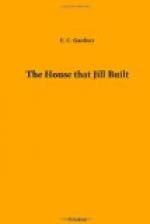[Illustration: THE CONTRIBUTION OF BESSIE’S FATHER.]
“For instance, in hot weather outside blinds that shield the glass from the direct rays of the sun keep the rooms cooler than any form of inside shutters; they allow a gradation of light and a free circulation of air. You can even leave the window open during a summer shower without danger of being drenched. Last but not least they are inexpensive. The wrong side of the outside blinds appears when you wish to make wide windows, or mullioned windows, or windows that cannot command at each side an unobstructed wall space equal to at least half their own width for the blinds to rest against when open. Under such circumstances, which are by no means rare, outside blinds are stubbornly unmanageable.
“Inside blinds that fold back and swing away from the windows must have wide recessed jambs to hold them when they are not in use. If the windows are broad these ‘pockets’ will require a thick wall and thus increase the actual size of the house. A little space may be saved by allowing them to stand out obliquely when open, or turn around upon the inside face of the wall, but either mode increases the cost of finishing the rooms. If these blinds are made of open slats, many housekeepers despise them as being no better than small cabinets maliciously contrived to accumulate dust; if of solid panels, they make a room perfectly dark, or when opened ever so slightly admit unbroken rays of sunlight. On the other hand, inside blinds are accessible; they can be opened and closed without leaning half one’s length out of the window; they do not hide the glory of plate glass; they graciously permit windows to stand where they please and to be as large as they please; and they never quarrel with piazza roofs, awnings, hoods or other outside accessories.
“Shutters that coil up into a box over the window or down into a box below it have the modest excellence of being always out of the way when they are not wanted, of staying where they are put when partially open, of occupying but little space and never standing in the way of the window curtains. They are, in fact, wooden shades similar to the old-fashioned green slat curtains, that were rolled up by drawing a cord, but are far more substantial. The single slats of which they are composed do not revolve, and consequently it is not easy to ’peep through the blind just to hear the band play.’
“Venetian shades, with their multiplicity of bright-colored straps, cords, hooks and trimmings, are picturesque and graceful. They are somewhat subject to dust and repairs, and when the window is open are not proof against tornadoes and thunder showers.
“Inside blinds are sometimes contrived to slide sideways, like barn doors, into cavities formed to receive them. If built with extreme care and handled with the utmost tenderness they are a degree less obtrusive than when wholly dependent on hinges. Likewise, outside blinds may be contrived to swing horizontally as well as vertically, standing out from the top of the window like a small shed roof. They are not quite wide enough to serve as awnings, and are liable to catch more wind than they can hold.”




